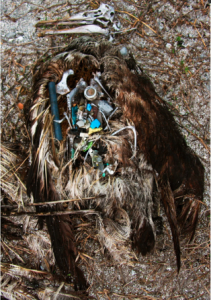Marine Pollution: A Look into the Great Pacific Garbage Patch
By Hannah Armstrong, RJD Intern
Plastics, among other pollutants, are one of the most commonly found in oceans and on beaches globally. This is mainly for two reasons: first, plastic is very durable and often low in cost, so it is universally used for consumer and industrial products, and second, plastics do not biodegrade completely, remaining in the world’s oceans and on beaches for extended periods if not cleaned up. All of this accumulating debris can be detrimental for marine life. Seals, turtles and seabirds often get entangled and drown in abandoned fishing nets and other miscellaneous debris, and toxins both from the breakdown of plastics and those that the plastics themselves absorb, can collect in marine organisms and be damaging to their health and to the aquatic food web as a whole.
In the North Pacific Ocean, there is a gyre that has caused such a drastic collection of debris that it has earned the name The Great Pacific Garbage Patch. A gyre, as defined by the National Oceanic and Atmospheric Administration (NOAA), is a major spiral of ocean-circling currents; global winds result in ocean currents circling clockwise in the Northern Hemisphere and counter-clockwise in the Southern Hemisphere, with an area of high pressure in the center. In the North Pacific Subtropical Gyre, these ocean circulation patterns are what caused, and is still causing, the substantial amount of debris accumulation, ultimately forming the Great Pacific Garbage Patch. The Great Pacific Garbage Patch is comprised of the Eastern Garbage Patch, which is located near Japan, and the Western Garbage Patch, which is located in the waters between California and Hawaii.

A representation of the ocean currents and zones in the North Pacific Region. The two green shaded circles depict the Western and Eastern Garbage Patches, where a substantial amount of marine debris has accumulated (Howell et al. 2012).
Charles Moore, the oceanographer who was among the first to draw media attention to the Great Pacific Garbage Patch, noted that in the last two decades alone, the deposition rate of plastic accelerated past the rate of production. Moreover, his research on plastics in the ocean showed that between 1960 and 2000, the world production of plastic resins increased 25-fold, while recovery of the material remained below 5%; and between 1970 and 2003, plastics became the fastest growing segment of the US municipal waste stream, increasing nine-fold. According to Moore, marine litter is now 60–80% plastic, reaching 90–95% in some areas (Moore 2008). This build-up is already beginning to render its consequences on the marine environment and its inhabitants.
The most obvious concern with a debris build-up caused by the previously described convergence zones is the negative effects it poses on the marine life. Specifically, this pollution affects at least 267 species worldwide, including sea turtles (86%), seabirds (44%), and marine mammal species (43%) (Laist 1997). In 2009, Young et. al directed their attention toward an area southeast of the Kroshio Extension near Japan. They observed a population of Laysan Albatross (Phoebastria immutabilis), taking note that the foraging area of adult albatross originating from Kure Atoll overlapped with the range of the Western Garbage Patch. This, they realized, is what lead to the transfer of marine plastics from adult albatross to their young. In fact, the albatross chicks from Kure Atoll, in comparison to the Oahu albatross sample used, were fed nearly ten times the amount of plastic despite having a relatively similar amount of available natural food. While Young et al. were unable to determine the level of mortality as a result of this plastic ingestion, they did observe mechanical blockage of the digestive tract, reduced food consumption, satiation of hunger, and potential exposure to toxic compounds (Young et al. 2008).

A photograph of a dead Laysan albatross chick with a diversity of plastics in its stomach. Ingestion of marine debris is a detrimental issue or marine organisms and seabirds (Young et al. 2008).
In addition to threats of ingesting pollutants, marine species face threats of entanglement and a phenomenon known as “ghost fishing.” This occurs when fishing gear is lost or abandoned, but continues to fish and wipeout resources (Moore 2008). As a means of remediating entanglement, often a result of nets and six-pack soda rings among other pollutants, some manufacturers aim to chemically alter the plastic in the event that it ends up in the ocean. Chemical changes can allow the polymer to absorb UV-B radiation from sunlight, breaking it down into a smaller, less-harmful product. The resulting polymer, however, is hardly more biodegradable (Moore 2008).
With the ever-increasing abundance of plastics in the marine environment, concerns too, are growing. With other environmental problems, most notably climate change, it will be critical to begin (and continue) to study and understand how rising atmospheric and sea temperatures will affect ocean circulation, wind and debris movement patterns. If drastic changes occur within the North Pacific region, and specifically the area encompassed by the Great Pacific Garbage Patch, then the resulting marine pollution accumulation and retention and could be drastic as well.
References:
Derraik, Jose G.B. The pollution of the marine environment by plastic debris: a review. Marine Pollution Bulletin 44 [842-852]. 2002.
Howell, Evan A et al. On North Pacific circulation and associated marine debris concentration. Marine Pollution Bulletin 65-1 [16-22]. 2012.
Moore, Charles James. Synthetic polymers in the marine environment: A rapidly increasing, long-term threat. Environmental Research 108-2 [131-139]. 2008.
Young, Lindsay C et al. Bring Home the Trash: Do Colony-Based Differences in Foraging Distribution lead to Increased Plastic Ingestion in Laysan Albatrosses? Plos One. 2009.
